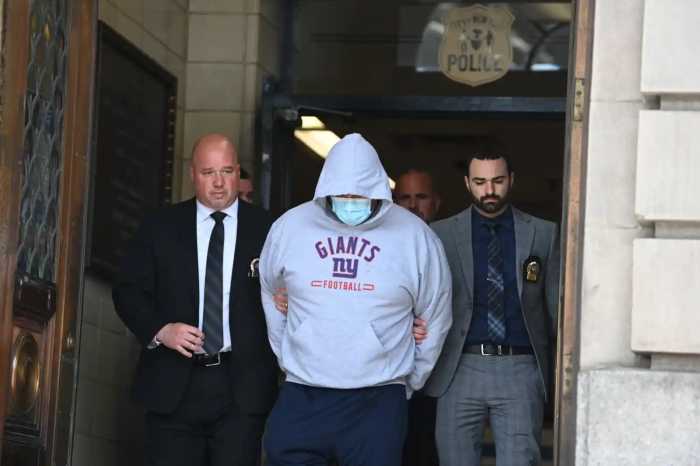After “exhaustive” investigations by her Conviction Integrity Unit (CIU), Queens District Attorney Melinda Katz filed motions on Aug. 24 with defense attorneys to vacate three wrongful convictions after new evidence came to light. The drama played out over nearly two hours before Queens Supreme Court Justice Michelle Johnson, who granted the motions and dismissed the indictments against the three men who were present in her Kew Gardens courtroom.
CIU director Bryce Benjet presented the new evidence after a review of the case against Armond McCloud and Reginald Cameron found that their confessions in the 1994 shooting death of Kei Sunada at LeFrak City were unreliable because they were elicited by NYPD Det. Carlos Gonzalez, who is connected with two cases involving false confessions — the “Central Park Five” rape case in 1989 and the 1990 murder of a tourist from Utah who was in New York City to attend the U.S. Open in Flushing Meadows Corona Park.
Benjet also presented new evidence in the case of Earl Walters in which fingerprints implicated other men in the 1992 abductions and robberies of two women for which Walters served 20 years in prison.
“Fairness in the criminal justice system means we must re-evaluate cases when credible new evidence of actual innocence or wrongful conviction emerges,” Katz said. “Those who have served prison time for crimes they demonstrably did not commit deserve to have the slate wiped clean.”
In the People v. Walters case, on Sept. 2, 1992, two men approached a 22-year-old woman in Borough Park, Brooklyn, as she got out of a friend’s car in front of the building that she lived in when she was pistol-whipped and forced to lie on the floor in the back of the car. The assailants rifled through her belongings finding an ATM card and demanded the victim provide the PIN to them. The car was driven to an ATM on Hillside Avenue in Jamaica where the men withdrew approximately $2,000 in cash. They let the woman out in Queens. The car was found abandoned and stripped months later with all potential forensic evidence destroyed.
In a second, similar incident at around midnight on Sept. 24, 1992, a 58-year-old woman was getting out of her car after parking near her Flushing home and putting a steering wheel lock on. Two men approached and forced her back into the vehicle, punching her in the face and slamming her head repeatedly into the steering wheel before throwing her into the back of the car. They demanded she give them her ATM card and PIN. She was sexually assaulted by one man as the other drove to an ATM to withdraw money from her account. They then dragged her out of the car, threw her over a fence near train tracks and urinated on her. After waiting to make sure the men were gone, the victim made her way to a bodega where she called 911.
At 2:47 a.m., police found a Mazda that had been stolen from Long Island at the location in Flushing where the woman was abducted. The car was double parked with the engine running. Earl Walters, then 17, emerged as a suspect in the carjackings during an investigation into an unrelated Sept. 21 carjacking and murder. Walters was ultimately considered only a witness in the murder. But during 16 hours of interrogation while in police custody without counsel, he made statements implicating himself and an accomplice in the two carjackings. Additionally, the victim in the Sept. 2 carjacking identified Walters in a lineup — though after first picking two other candidates and then conferring with a detective.
While Walters was in custody after his arrest, three other carjackings and robberies of women occurred that fit the same pattern as the incidents on Sept. 2 and 24. Three men, Kraigory Odom, Robert Masters and Jermaine Williams, were eventually charged. Walters was nonetheless convicted at trial in March 1994 and served 20 years. He was released to parole in April 2013. In 2020, his attorneys asked District Attorney Katz’s Conviction Integrity Unit (CIU) to review the case, specifically requesting that any fingerprints associated with the two carjackings be compared to those of the three men charged in the other, similar crimes.
Utilizing fingerprint database technology that was not available at the time of Walters’ trial, the NYPD Latent Print Section re-examined the available fingerprint evidence and obtained a match to Williams as a source of fingerprints in the Mazda in the Sept. 24 carjacking. Individual comparisons also associated Masters with a print found in the car. There was no evidence that Walters was associated with either of the men. He was excluded as a source of any of the forensic evidence in the case.
In the cases of McCloud and Cameron, Kei Sunada, 22, a Japanese national, returned to his home at the Columbia building in Lefrak City on Aug. 4, 1994, at about 11:15 p.m. About five minutes later, a tenant reported hearing shots fired and Sunada was found by a LeFrak City peace officer on the landing of a fourth-floor stairwell with a gunshot wound to the head. He died three days later.
Initial NYPD paperwork contained significant errors. Detective Carlos Gonzalez inaccurately reported that Sunada was found lying face down in a pool of blood in a fourth-floor hallway, not the stairwell. Another officer incorrectly noted that Sunada was shot twice, not once. Armond McCloud, who was 20 years old at the time, and Reginald Cameron, who was 19, became suspects after a 16-year-old being questioned in an unrelated robbery told police that he overheard “people saying” that someone who fit McCloud’s description killed Sunada.
McCloud and Cameron were arrested without probable cause at around 7 p.m. Aug. 8. They were interrogated for several hours without counsel by multiple detectives. At around 3:30 a.m. the next morning, some eight-and-a-half hours after his arrest, Cameron signed a written confession while being interrogated by Detective Gonzalez, who then took over questioning McCloud and obtained a confession at around 4:30 a.m. Both Cameron and McCloud gave video-taped statements later that day with Detective Gonzalez present. Both men’s confessions described a robbery in a fourth-floor hallway. McCloud said the gun accidentally discharged when Sunada struck his hand with a defensive karate kick.
The confessions, however, did not match the facts of the crime and did not accurately describe the victim. The inaccuracies in the confessions mirrored errors in the police reports.
For example, both statements incorrectly described the crime as taking place in the hallway, rather than the stairwell, reflecting an error in police reports drafted by Detective Gonzalez. Additionally, Cameron said two shots were fired, an inaccuracy also found in the initial NYPD complaint report. Inaccuracies in confessions that are similar to an interrogator’s own misunderstandings are commonly referred to as “false fed facts,” and may indicate that the substance of a confession came from the interrogator, not direct knowledge of the crime.
McCloud and Cameron both later recanted, arguing that their confessions were coerced. McCloud said he falsely confessed because he was hungry and thirsty and believed his innocence would come to light in court. Cameron described coercive interrogation techniques in pretrial hearing testimony.
McCloud was convicted of murder at trial in 1996 and sentenced to 25 years to life. After learning of McCloud’s conviction and sentence, Cameron decided to plead guilty to robbery in the first degree in exchange for the dismissal of murder charges. At the time of the plea, Cameron had already served more than half of the recommended 3.75-year minimum sentence in pretrial detention.
After serving more than 28 years, McCloud was released in January 2023. Cameron served more than eight years in prison before his release to parole in 2003.
Katz’s CIU began investigating the case after an internal review uncovered potential discrepancies between the facts of the crime and the confessions that were the basis for the convictions.
A crime scene reconstruction expert who was engaged to assist in the investigation visited the scene at LeFrak City and determined that the shooting did not occur in the hallway, as stated in police reports, and could only have happened in the stairwell, where the victim’s body had been discovered. Additionally, after McCloud and Cameron were convicted based entirely on their confessions to Detective Gonzalez, other convictions based on confessions secured by the detective were vacated.
In 2002, the 1990 convictions of the “Central Park Five” were vacated. And in 2015, the conviction of Johnny Hincapie was vacated. Hincapie served 25 years in prison accused of the 1990 stabbing death of a Utah native visiting New York to attend the U.S. Open Tennis Championships. In both cases, defendants falsely confessed after interrogations involving Detective Gonzalez.
In the motion to vacate the convictions of McCloud and Cameron, Katz cites Detective Gonzalez’s record of eliciting false confessions, the unreliability of the defendants’ confessions and the absence of reliable evidence implicating either man in Sunada’s murder. All three men were in the courtroom and expressed their gratitude to the DA’s office and her Conviction Integrity Unit. Cameron’s remarks to the court were laced with regret.
“Although I’m happy it doesn’t fix things to me, it doesn’t fix the scar on my face,” Cameron said. “It doesn’t fix that on the day they arrested me, I had just passed the MTA exam. Like, these are the things I can’t get back. People that passed away while I was incarcerated, I couldn’t see buried. These are things that no one can fix or replace. I suffer from depression because of it.”
Including the three motions filed Thursday, the CIU has vacated 102 convictions since the office was launched by Katz in 2020. The unit dismissed 86 convictions based on the unreliable police work of former detectives later convicted of crimes committed on the job that undermined their credibility. Another 16 convictions have been vacated for a variety of other reasons, including newly discovered evidence.



































